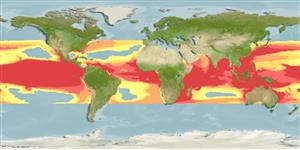>
Carangiformes (Jacks) >
Carangidae (Jacks and pompanos) > Caranginae
Etymology: Uraspis: Greek, oura = tail + Greek, aspis = shield (Ref. 45335).
More on author: Poey.
Environment: milieu / climate zone / intervalo de profundidade / distribution range
Ecologia
marinhas pelagic-oceanic; oceanódromo (Ref. 51243); intervalo de profundidade 1 - 50 m (Ref. 89972), usually 2 - 15 m (Ref. 40849). Subtropical; 42°N - 34°S, 180°W - 180°E
Worldwide in warm waters. Western Indian Ocean: Tanzania (Ref. 3287, 3197). Eastern Central Pacific: California, USA to Costa Rica (Ref. 2850). Also in Hawaii. Western Atlantic: Massachusetts, USA and northern Gulf of Mexico to Brazil. Eastern Atlantic: Mauritania to Angola (Ref. 7097); also Algoa Bay, South Africa (Ref. 3197).
Tamanho / Peso / Idade
Maturidade: Lm ? range ? - ? cm
Max length : 50.0 cm TL macho/indeterminado; (Ref. 7251); common length : 40.0 cm TL macho/indeterminado; (Ref. 26999); peso máx. Publicado: 2.0 kg (Ref. 40637)
Espinhos dorsais (total) : 9; Raios dorsais moles (total) : 27 - 32; Espinhos anais: 3; Raios anais moles: 19 - 23. Adults dark to bluish black; juveniles with 6-7 dark bands with pale interspaces (Ref. 3197).
Body shape (shape guide): fusiform / normal.
Adults are mostly oceanic and pelagic but sometimes found near the bottom, often near islands. Solitary or in small schools (Ref. 2850).
Life cycle and mating behavior
Maturidade | Reprodução | Desova | Ovos | Fecundidade | Larvas
Smith-Vaniz, W.F., J.-C. Quéro and M. Desoutter, 1990. Carangidae. p. 729-755. In J.C. Quero, J.C. Hureau, C. Karrer, A. Post and L. Saldanha (eds.) Check-list of the fishes of the eastern tropical Atlantic (CLOFETA). JNICT, Lisbon; SEI, Paris; and UNESCO, Paris. Vol. 2. (Ref. 7097)
Categoria na Lista Vermelha da IUCN (Ref. 130435: Version 2025-1)
Ameaça para o homem
Harmless
Utilização humana
Pescarias: pouco comercial; peixe desportivo: sim
Ferramentas
Relatórios especiais
Descarregue XML
Fontes da internet
Estimates based on models
Preferred temperature (Ref.
123201): 20.9 - 29.1, mean 27.2 °C (based on 41503 cells).
Phylogenetic diversity index (Ref.
82804): PD
50 = 0.6250 [Uniqueness, from 0.5 = low to 2.0 = high].
Bayesian length-weight: a=0.01122 (0.00514 - 0.02450), b=3.04 (2.87 - 3.21), in cm total length, based on all LWR estimates for this body shape (Ref.
93245).
Nível Trófico (Ref.
69278): 4.0 ±0.5 se; based on size and trophs of closest relatives
Resiliência (Ref.
120179): Médio, tempo mínimo de duplicação da população 1,4 - 4,4 anos (Preliminary K or Fecundity.).
Fishing Vulnerability (Ref.
59153): Moderate vulnerability (40 of 100).
🛈
Nutrients (Ref.
124155): Calcium = 93.5 [50.8, 205.8] mg/100g; Iron = 1.64 [0.88, 3.02] mg/100g; Protein = 20.1 [18.9, 21.4] %; Omega3 = 0.409 [0.251, 0.700] g/100g; Selenium = 18.9 [9.9, 37.8] μg/100g; VitaminA = 11.2 [3.5, 34.5] μg/100g; Zinc = 0.693 [0.484, 1.037] mg/100g (wet weight);
